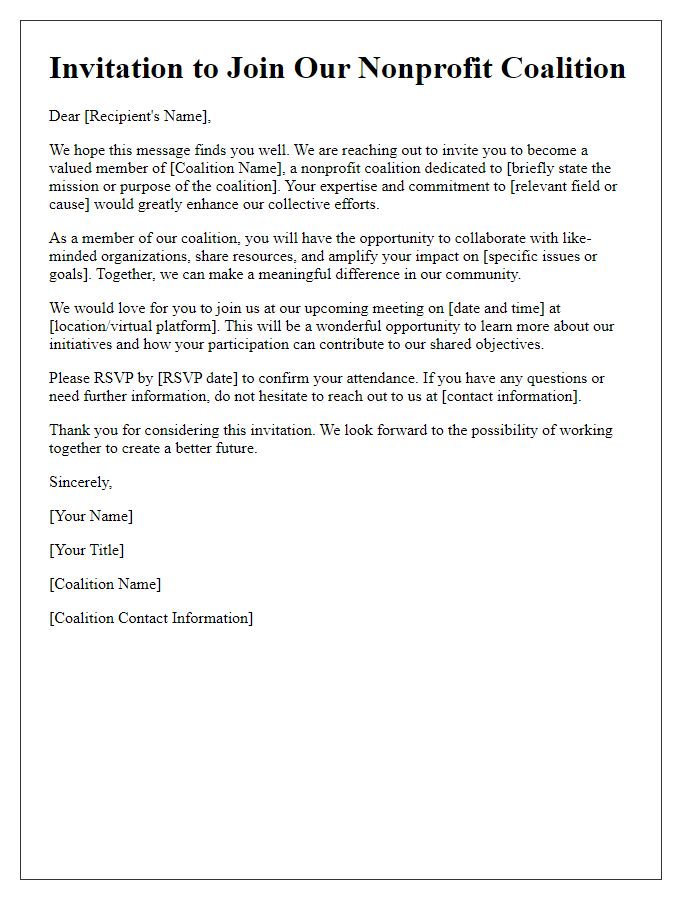Are you passionate about making a difference in your community? Forming a nonprofit coalition can be an exciting way to unite like-minded individuals and organizations for a common cause. This article will guide you through the essential steps to create a successful nonprofit coalition, highlighting the benefits of collaboration and shared resources. So, if you're ready to take the first step towards meaningful change, keep reading!

Clear Mission Statement
A clear mission statement is essential for nonprofit coalitions aiming to unify diverse organizations under a common goal. It should succinctly articulate the coalition's purpose while addressing critical societal issues, such as food insecurity, environmental sustainability, or social justice. An effective mission statement typically focuses on specific populations, like underserved communities or marginalized groups, and outlines key objectives, including advocacy, education, and resource mobilization. This guiding principle serves to inspire collaboration among member organizations and community stakeholders, fostering a shared vision and collective impact. A well-defined mission statement can attract funding opportunities and enhance community engagement by clearly communicating the coalition's values and goals.
Defined Goals and Objectives
Nonprofit coalitions aim to unite diverse organizations toward a common purpose, addressing pressing social issues such as poverty, education, or health care. Defined goals may include increasing community awareness about homelessness (affecting over 650,000 individuals in the United States) and advocating for policy changes at local government levels. Objectives often involve conducting outreach programs in underserved neighborhoods, initiating training workshops for volunteers, and building partnerships with local businesses and schools. By establishing measurable targets, such as reaching 5,000 community members within two years or securing funding for 10 outreach events, coalitions enhance their effectiveness and ensure accountability among participating organizations. These collective efforts ultimately seek to create a sustainable impact on the communities served, particularly in regions experiencing high unemployment rates or inadequate access to resources.
Member Roles and Responsibilities
Member roles and responsibilities within a nonprofit coalition formation are vital for ensuring effective collaboration and achieving common goals. Each member organization, such as local community groups, service providers, and advocacy organizations, contributes unique strengths and resources. Responsibilities may include active participation in coalition meetings, which typically occur monthly, sharing expertise related to specific issues like public health or education reform, and facilitating outreach efforts to engage wider community participation. Additionally, financial contributions or in-kind services may be expected from members, such as meeting space or logistics support, to sustain operational costs. Member organizations are also responsible for reporting progress on assigned tasks and initiatives to assess accountability and transparency within the coalition framework. Effective communication, commitment to the coalition's mission, and collaborative project planning are essential components of successful member participation in the nonprofit sector.
Partnership Terms and Conditions
The partnership terms and conditions for a nonprofit coalition formation outline the fundamental agreements and responsibilities among participating organizations, ensuring a cohesive collaboration towards shared goals. This document should include critical elements such as a clear definition of roles for each member organization, accountability measures, and mechanisms for conflict resolution to address disputes. Financial contributions, potential funding sources, and resource sharing agreements must also be detailed, ensuring transparency regarding how funds will be utilized. Additionally, guidelines on decision-making processes should be established, highlighting how members will engage in strategy development and priority setting. Regular assessments and reporting requirements should be stipulated to monitor progress and maintain alignment with the coalition's mission, ultimately reinforcing cooperation and commitment to community impact.
Communication and Decision-Making Protocols
Effective communication and decision-making protocols are crucial for nonprofit coalitions to operate successfully. Clear guidelines ensure that all stakeholders, including representatives from various organizations, engage in meaningful dialogue. Regular meetings, ideally monthly at community centers or through virtual platforms like Zoom, foster transparency and collaboration. Using tools such as Slack or Microsoft Teams can streamline ongoing discussions and document sharing. Establishing a decision-making framework, such as consensus or majority voting, clarifies how choices are made. Additionally, documenting processes and decisions in a centralized location, like Google Drive, enhances accountability and provides historical context for future reference. By implementing these strategies, coalitions can efficiently navigate challenges and maximize their collective impact on social issues.
Letter Template For Nonprofit Coalition Formation Samples
Letter template of collaboration request for nonprofit coalition formation













Comments